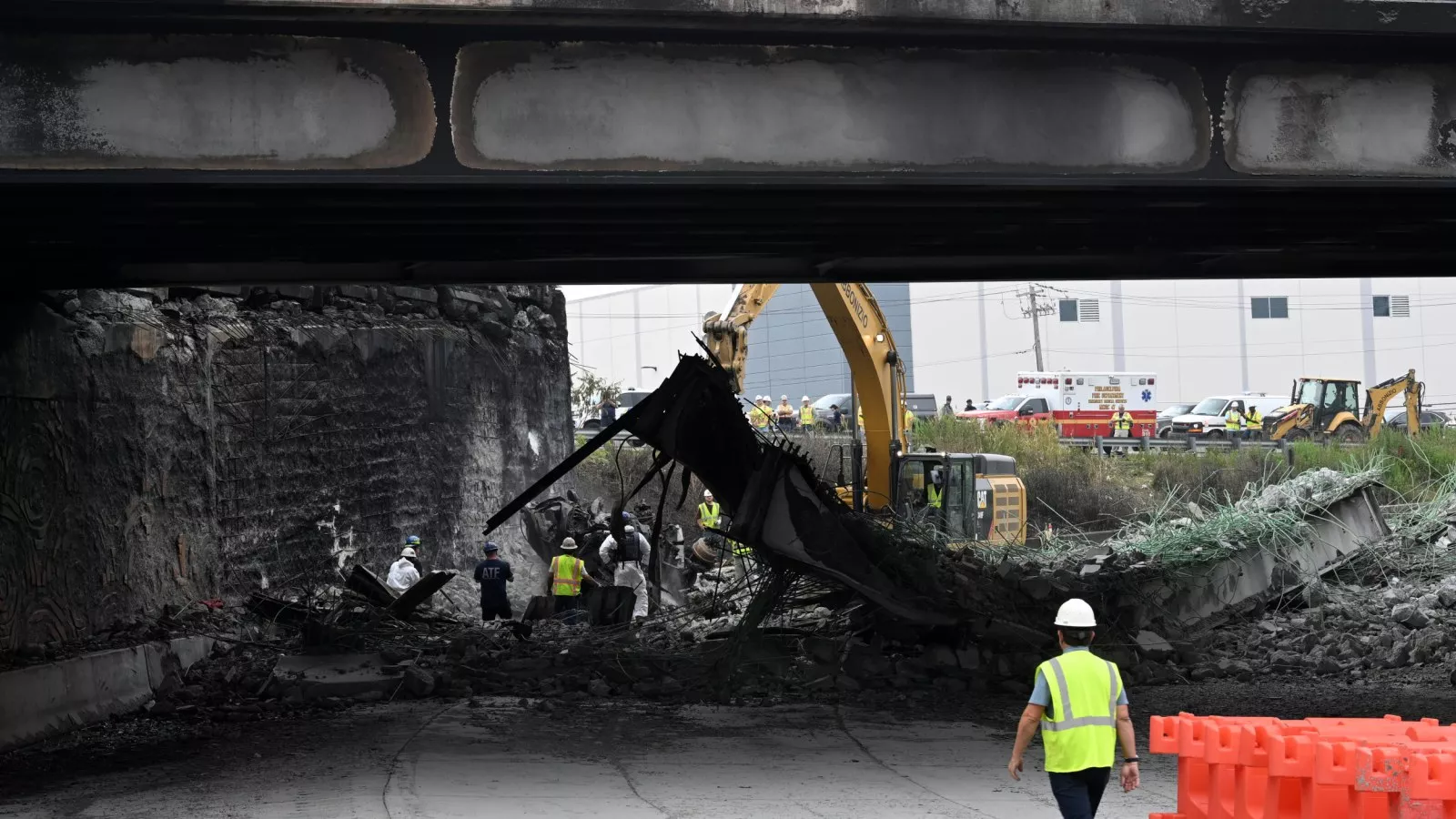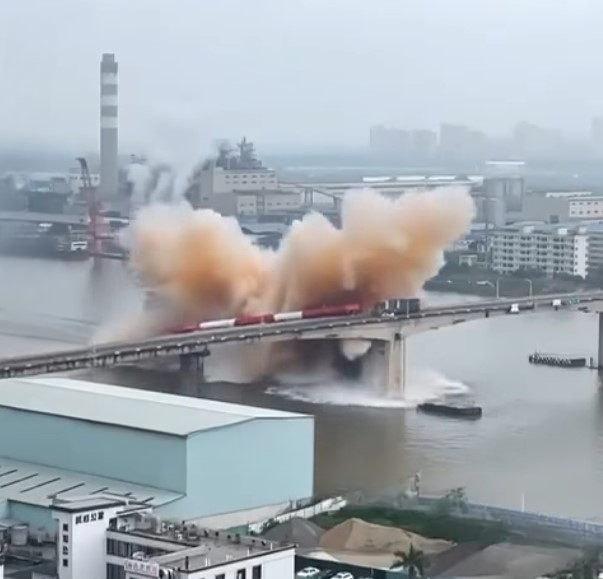In an era dominated by short-form content, a few seconds of footage can shift public perception, stir anxiety, and ignite global discussion. One such video—now circulating widely under the nickname “Seconds from Collapse”—has done exactly that.
What begins as a seemingly ordinary roadside scene transforms into something eerily tense. A large fuel tanker sits motionless beneath a visibly damaged bridge. Cracks snake through the concrete. The support beams appear strained. The faint creak of shifting metal sends a chill through anyone watching. Each subtle movement of the structure suggests that catastrophe might be only moments away.
The clip, which lasts less than half a minute, provides no context—no location, no date, no explanation. But that hasn’t stopped millions of viewers across TikTok, YouTube, X (formerly Twitter), and Facebook from trying to uncover its story.
Is this footage of a real bridge on the brink of collapse?
Was it filmed during a controlled demolition or safety inspection?
Or is it a staged awareness video meant to highlight the dangers of neglected infrastructure?
No one seems to know for sure. Yet what’s certain is this: the video has struck a nerve, exposing the deep public unease about the safety of the very structures we trust every day.

The Scene That Captured the World’s Attention
It starts simply. The camera pans toward a stationary tanker under a weathered bridge. Sunlight filters through the gaps in the concrete. To the casual observer, it might seem routine—a delivery vehicle paused in traffic. But a closer look reveals alarming details: fractured support beams, chunks of exposed rebar, and the unmistakable tension of a structure under stress.
Viewers quickly picked up on the unease. “That bridge is seconds from disaster,” one comment read. “I hope this is staged,” another wrote. Within hours of its first upload, the video had been viewed millions of times and shared thousands more.
In an online environment where content is often fleeting, this particular clip lingered—because it spoke to a primal fear: the sudden collapse of the familiar.
The Psychology of Fear and Fascination
Why do millions of people keep watching a short, context-free video of a potential disaster? Psychologists point to a concept called “vicarious vigilance”—our instinctive need to monitor threats, even when we’re safe.
Dr. Elisa Moreno, a behavioral science researcher who studies viral media trends, explains:
“When people watch a video like this, they experience a rush of anxiety mixed with relief. It’s the same response as slowing down to look at an accident from a distance—it’s not morbid curiosity; it’s an unconscious need to assess danger so we can feel prepared.”
In other words, such clips let us experience fear safely, while also reflecting on the fragility of everyday life.

The Power of the Unknown: Why Context Matters
The lack of clear context only intensifies the clip’s impact. Some versions of the video claim to show a real bridge moments before a collapse. Others insist it’s part of a safety campaign created to raise awareness about decaying infrastructure. Still others argue it might have been taken during a demolition or a structural test.
Without verification, speculation fills the void. Viewers around the world projected their own fears and memories—recalling images of real bridge failures, tragic collapses, and aging structures they cross daily.
This ambiguity transforms the clip from a simple video into a mirror reflecting global anxiety. Whether genuine or staged, it highlights a growing truth: the modern world’s infrastructure—bridges, roads, pipelines, and tunnels—may not be as invincible as we imagine.
Real-Life Disasters That Echo the Video
Even if this viral clip remains unexplained, it evokes painful memories of real incidents. Across continents, infrastructure failures have led to tragedy, loss, and urgent reform.
-
Taiwan (2019) – The sudden collapse of the Nanfang’ao Bridge sent a tanker and several fishing boats plunging into the water below. Footage of the event shocked the world, showing how a seemingly stable structure could give way in seconds.
-
India (2025) – The Gambhira Bridge in Gujarat failed during morning traffic, leaving a tanker dangling from twisted steel. Emergency responders worked for hours to prevent further damage and loss.
-
Brazil (2024) – A highway bridge gave way as a tanker carrying hazardous materials crossed. The event triggered national debates about infrastructure spending and environmental preparedness.
Each of these tragedies serves as a haunting reminder of what’s at stake. The viral “tanker under the bridge” video resonates because it feels possible—too possible.
A Wake-Up Call About Aging Infrastructure
The truth is that much of the world’s infrastructure is aging faster than it’s being repaired. Many bridges, especially in North America, Europe, and parts of Asia, were built more than 50 years ago. They were designed for traffic volumes far lower than today’s levels.
According to the American Society of Civil Engineers (ASCE), more than 40% of U.S. bridges are over half a century old, and thousands are rated as structurally deficient. That doesn’t mean they’re unsafe to cross—but it does mean they require continuous maintenance and funding.
When funding is delayed or inspections overlooked, even minor cracks can lead to catastrophic results.
Dr. James Holloway, a civil engineer specializing in structural resilience, notes:
“Bridges are like living systems. They age, they expand and contract, and they respond to stress. What starts as a small fracture can, over time, become a fatal flaw—especially when weather, vibration, and heavy loads add constant pressure.”
The Global Picture: Infrastructure in Decline
The issue extends far beyond one country. In Europe, the collapse of Italy’s Morandi Bridge in 2018 sparked continent-wide calls for reform. In Asia, rapid industrial growth has sometimes outpaced inspection systems. In Africa and South America, limited maintenance funding leaves thousands of structures at risk.
The viral video struck a global chord because infrastructure failures transcend borders. They symbolize something universal: how progress and neglect often coexist side by side.
The Internet’s Role: From Information to Amplification
Social media amplifies emotion faster than fact. When the tanker clip surfaced, millions of users shared it before any credible source could verify its origins. Algorithms favor engagement—fear, curiosity, and shock drive shares more than nuance.
Yet, paradoxically, this virality also creates awareness. Discussions in the comments sections quickly shifted from “Is this real?” to “How safe are the bridges in my city?”
Public agencies and engineers soon joined the conversation, using the viral momentum to emphasize inspection protocols and encourage funding for infrastructure renewal.
The result? A 20-second video became a global public safety discussion—a case study in how modern media spreads both misinformation and awareness at the same time.
How Governments and Engineers Respond
When clips like this go viral, they often prompt temporary waves of attention. Governments issue statements reassuring citizens of inspection efforts, while engineers seize the opportunity to educate the public.
Several transportation agencies across North America and Europe released informational posts emphasizing regular safety checks, investment programs, and new technologies such as structural health monitoring sensors—devices that detect strain or cracks before visible damage occurs.
In countries like Japan, where seismic activity presents additional risks, bridges are regularly reinforced with base isolation systems and shock absorbers that help them withstand earthquakes.
The viral video, whether authentic or staged, becomes a conversation starter—a visual reminder of why these technologies and investments matter.
A Metaphor for Modern Vulnerability
Beyond engineering and policy, the image of a tanker beneath a crumbling bridge carries metaphorical weight. It reflects the human condition in an age of uncertainty.
Just as the bridge holds the tanker, modern society bears immense strain—economic, environmental, and emotional. The cracks in concrete mirror the fractures in systems people once trusted: governance, infrastructure, even information itself.
In that sense, the video’s haunting stillness speaks to more than structural decay—it becomes a symbol of fragility in a world built on the illusion of permanence.
Courage and Resilience in Real Collapses
When bridges do fail, human courage often emerges in astonishing ways. In several documented incidents, drivers, construction workers, and first responders acted within moments to save others.
During the Nanfang’ao Bridge collapse, fishermen nearby used their boats to rescue survivors. After the I-95 bridge fire in the U.S., emergency crews worked around the clock to rebuild a temporary section within weeks.
These real stories remind us that while structures may fail, human compassion and resilience can hold firm.
The Importance of Preventive Action
The “Seconds from Collapse” clip may or may not depict a real event—but the lesson it conveys is universal: prevention saves lives.
Infrastructure experts emphasize that most catastrophic collapses are not sudden surprises; they’re the result of small warning signs ignored over time. Funding shortages, bureaucratic delays, and complacency all contribute.
Communities can reduce risk through proactive measures:
-
Routine Inspections: Frequent assessments by structural engineers.
-
Transparent Reporting: Making inspection results publicly available.
-
Investment in Upgrades: Prioritizing repair over replacement when possible.
-
Public Awareness: Educating citizens on how to report signs of structural stress.
Each of these steps transforms fear into preparedness.
What the Video Teaches About Media Literacy
The tanker clip also underscores the need for digital discernment. As audiences, it’s easy to assume what we see online is real, especially when it triggers emotional responses.
Media analysts recommend three quick checks before sharing such content:
-
Reverse Image Search: Identify if the footage existed before the viral upload.
-
Verify Location and Date: Look for landmarks or signage.
-
Consult Official Sources: Check for statements from local authorities or credible news outlets.
Practicing these habits helps prevent misinformation and keeps important topics—like infrastructure safety—grounded in truth.
A Call for Global Collaboration
Addressing the risks highlighted by this viral moment requires global cooperation. Countries with advanced monitoring technology can share best practices with those lacking resources. International engineering coalitions already exist, but greater investment in knowledge exchange could save lives.
Infrastructure is not just concrete and steel—it’s a lifeline connecting communities, economies, and cultures. When one bridge collapses, it sends ripples through society’s collective consciousness.
The Emotional Resonance of Safety
At its emotional core, this story isn’t about fear—it’s about our shared longing for safety. When we cross a bridge, we trust that unseen hands—engineers, workers, inspectors—have ensured our passage is secure.
That quiet confidence underpins civilization itself. The viral clip shakes that trust for a moment, making us pause and appreciate the people and processes that keep daily life functioning smoothly.
It reminds us that safety isn’t passive—it’s earned, maintained, and constantly renewed.
The Broader Lesson: Attention Before Tragedy
Whether or not the viral “Seconds from Collapse” video depicts a real event, its influence is undeniable. It forces society to confront an uncomfortable truth: we often act only after catastrophe.
If we can learn to respond to warnings—structural, environmental, or social—before disaster strikes, we transform fear into foresight.
Conclusion: From Viral Fear to Lasting Awareness
The image of a fuel tanker paused beneath a fractured bridge is more than a viral moment—it’s a reflection of modern vulnerability and resilience.
It reminds us that while technology connects us faster than ever, the physical structures supporting that connection need equal attention. It reminds policymakers that infrastructure is not merely a budget line—it’s a lifeline. And it reminds everyday citizens that vigilance and empathy go hand in hand.
Preparedness is not paranoia. Maintenance is not waste. These truths, though simple, save lives.
So whether the clip is real or staged, the takeaway remains powerful: Every crack we ignore today becomes tomorrow’s collapse.
By investing in safety, education, and compassion, societies can ensure that future viral clips inspire not fear—but pride in what humanity can build, protect, and preserve.
